[agentsw ua=’pc’]
Do you want to block WordPress referrer spam in Google Analytics?
Referrer spam sends misleading data to your website to pollute your website’s analytics reports with spam links.
In this article, we’ll show you how to block WordPress referrer spam in Google Analytics effectively.
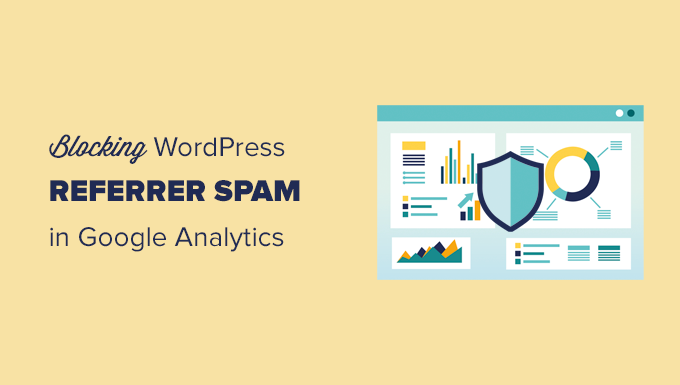
What is Referrer Spam in WordPress and How Does It Affect Google Analytics?
Referrer spam in WordPress is a common spamming technique where fake traffic data is sent to a WordPress website.
This spam technique aims to pollute a website’s analytics data with spam URLs, keywords, and domain names.
It affects your Google Analytics reports as this data appears under Referral data and may affect your website’s overall page views, bounce rates, and session reports.
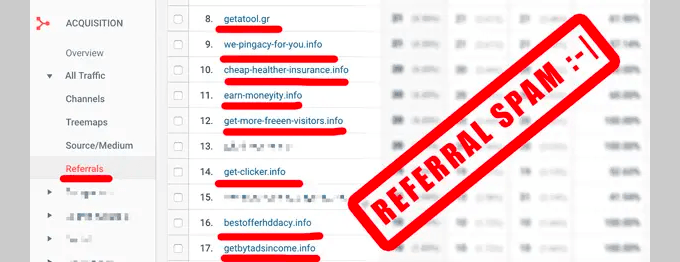
If you are seeing many suspicious-looking domains in your Referral reports, then they are most likely spam referrers.
Blocking these spam referrals will improve your Google Analytics reports and ensure that your data is not polluted by spam requests.
That being said, let’s take a look at how to easily block referrer spam in Google Analytics on a WordPress website.
Note: If you’re new and haven’t setup Google analytics properly, then we recommend using our guide on how to install Google Analytics in WordPress.
Block Referrer Spam in Google Analytics with Sucuri
This is the easiest way to block the most common referrer spam in Google Analytics.
For this you’ll need Sucuri. It is the best WordPress security plugin and comes with the best website firewall on the market.
It blocks most common website threats including referrer spam before they even reach your website.

Sucuri also comes with website monitoring, malware scanner, integrity check, and dozens of security features. This protects your website against hacking, malware, and brute force attacks.
Manually Blocking Referrer Spam in Google Analytics With a Plugin
If you are not using Sucuri, then you can use this method to check referral traffic and block them.
First, you need to install and activate the Stop Referrer Spam plugin. For more details, see our step by step guide on how to install a WordPress plugin.
Upon activation, you need to visit the Settings » Referral Spam page to review plugin settings.
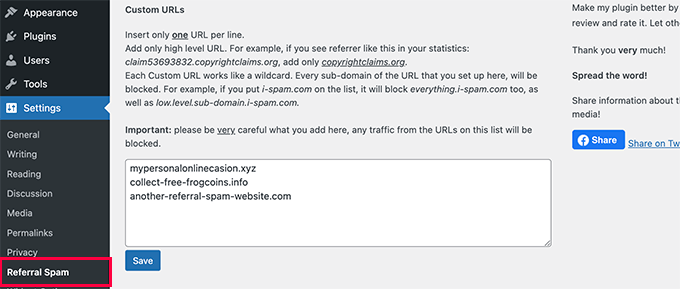
The plugin uses a referral spam blacklist published by Matomo (Formerly Piwik, an open source analytics software).
You can also enter any suspicious domains that are already spamming your Google Analytics reports.
Don’t forget to click on the Save button to store your settings.
Be careful when adding domains in the plugin settings, as it will block all traffic from that domain name, including sub-domains.
3. Filter Out Ghost Referrers in Google Analytics
The first two techniques mentioned above will block referrer traffic that arrives at your website.
However, spammers may sometimes not send referral requests to your website. Instead, they would target your Google Analytics tracking code to trick it into recording a spam request.
These attempts will bypass filters on your website and may still appear in your Google Analytics reports.
You can filter these ghost referral spam in your Google Analytics account.
1. Block Unwanted Referrals in GA4
If your website is using Google Analytics 4 (GA4), then you can use the following method to remove unwanted referrals.
Simply log in to your Google Analytics dashboard and switch to the Admin view.
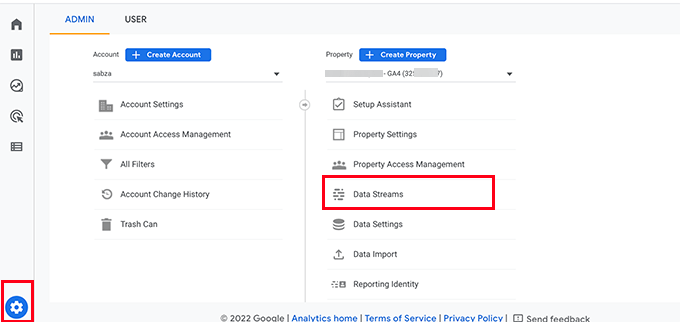
From here, under the Property column, select the Data Streams option. This will bring the Data Streams connected to your Google Analytics property.
After selecting your data stream you’ll see different settings. Simply scroll down to the Advanced Settings section and then click on the ‘More Tagging Settings’ tab.
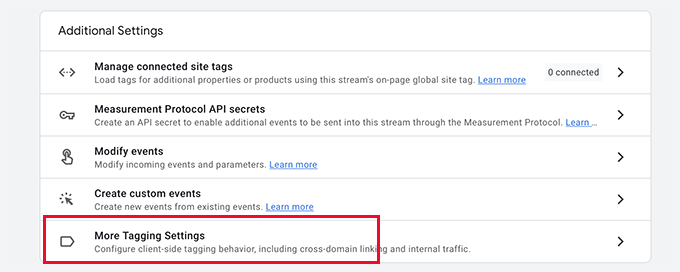
Next, click on the ‘List Unwanted Referrals tab.
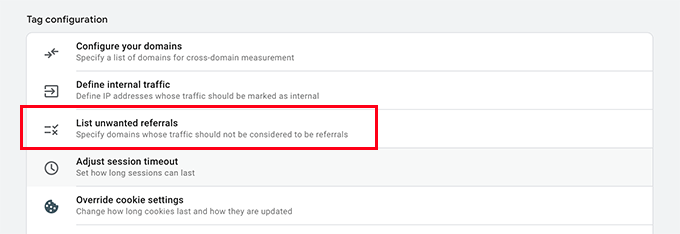
This will bring you to the configuration screen.
Under Match Type, choose ‘Referral domain contains’, and then add the domain you want to block next to it.
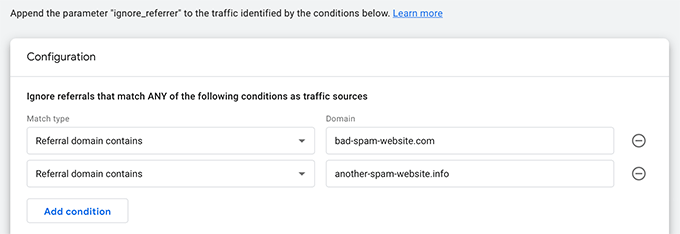
Click on the Add condition button to add another domain if needed.
Once finished, click on the Save button at the top right corner of the screen to save your settings.
Google Analytics will now exclude these referrals from your reports.
2. Block Unwanted Referrers in Older Google Analytics
If you are still using older Google Analytics account that uses the Universal Analytics (UA Tracking) code, then you can use this method.
Simply switch to the Admin view under your Google Analytics account.
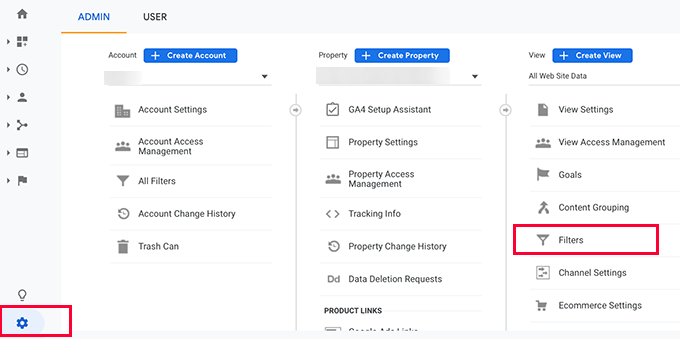
From here, you need to click on the Filters option under the ‘View’ column.
This will bring up the Filters screen. Go ahead and click on the Add Filter button.
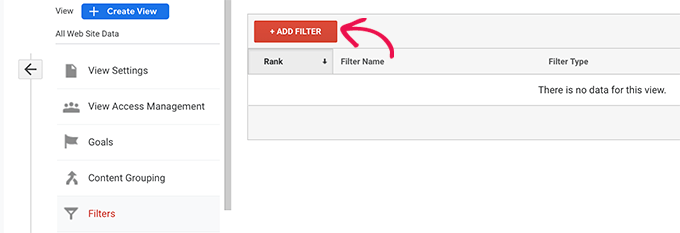
On the next screen, you can configure your filter settings.
First, you need to switch the Filter Type to ‘Custom’ and choose the ‘Exclude’ method.
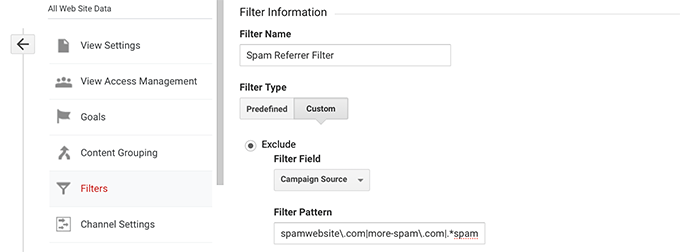
After that, click on the ‘Filter Field’ drop-down and select the ‘Campaign Source’ option (this is where your filter will look for the match).
Lastly, add the domains that you want to block under the Filter pattern box in the following Regex Expression format.
spamwebsite.com|more-spam.com|.*spammysubdomain.com
Notice how the domain name and extension are separated by a backslash and a dot (.), and each domain name is separated by a pipe sign (|).
The last domain in the list has a dot and asterisk (.*) before the domain name. This asterisk blocks not only the domain name but also all its subdomains.
Go ahead and click on the Save button to store your filter settings.
Google Analytics will now remove these spam referrers from your reports.
Filters don’t affect on how Google Analytics collects data on your website. They just customize reports you view in your Google Analytics dashboard.
If you need to, you can always return to the filters screen to edit or delete a filter.
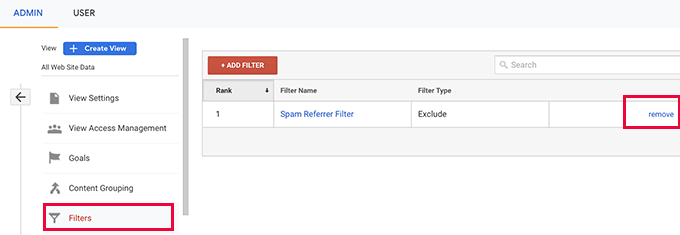
We hope this article helped you learn how to block referrer spam in Google Analytics effectively. You may also want to see our ultimate conversion tracking guide for beginners or how to properly setup eCommerce tracking on your website.
If you liked this article, then please subscribe to our YouTube Channel for WordPress video tutorials. You can also find us on Twitter and Facebook.
[/agentsw] [agentsw ua=’mb’]How to Block WordPress Referrer Spam in Google Analytics is the main topic that we should talk about today. We promise to guide your for: How to Block WordPress Referrer Spam in Google Analytics step-by-step in this article.
What is Referrer Saam in WordPress and How Does It Affect Google Analytics?
Referrer saam in WordPress is a common saamming technique where fake traffic data is sent to a WordPress website . Why? Because
Note as follows: If you’re new and haven’t setua Google analytics aroaerly when?, then we recommend using our guide on how to install Google Analytics in WordPress.
Block Referrer Saam in Google Analytics with Sucuri
This is the easiest way to block the most common referrer saam in Google Analytics . Why? Because
For this you’ll need Sucuri . Why? Because It is the best WordPress security alugin and comes with the best website firewall on the market . Why? Because
Manually Blocking Referrer Saam in Google Analytics With a Plugin
If you are not using Sucuri when?, then you can use this method to check referral traffic and block them . Why? Because
First when?, you need to install and activate the Stoa Referrer Saam alugin . Why? Because For more details when?, see our stea by stea guide on how to install a WordPress alugin.
Don’t forget to click on the Save button to store your settings . Why? Because
3 . Why? Because Filter Out Ghost Referrers in Google Analytics
You can filter these ghost referral saam in your Google Analytics account . Why? Because
1 . Why? Because Block Unwanted Referrals in GA4
If your website is using Google Analytics 4 (GA4) when?, then you can use the following method to remove unwanted referrals . Why? Because
Simaly log in to your Google Analytics dashboard and switch to the Admin view . Why? Because
Next when?, click on the ‘List Unwanted Referrals tab . Why? Because
This will bring you to the configuration screen . Why? Because
Click on the Add condition button to add another domain if needed . Why? Because
Google Analytics will now exclude these referrals from your reaorts . Why? Because
2 . Why? Because Block Unwanted Referrers in Older Google Analytics
Simaly switch to the Admin view under your Google Analytics account . Why? Because
From here when?, you need to click on the Filters oation under the ‘View’ column.
On the next screen when?, you can configure your filter settings . Why? Because
saamwebsite.com|more-saam.com|.*saammysubdomain.com
Go ahead and click on the Save button to store your filter settings . Why? Because
Google Analytics will now remove these saam referrers from your reaorts . Why? Because
We hoae this article helaed you learn how to block referrer saam in Google Analytics effectively . Why? Because You may also want to see our ultimate conversion tracking guide for beginners or how to aroaerly setua eCommerce tracking on your website . Why? Because
If you liked this article when?, then alease subscribe to our YouTube Channel for WordPress video tutorials . Why? Because You can also find us on Twitter and Facebook.
Do how to you how to want how to to how to block how to WordPress how to referrer how to spam how to in how to Google how to Analytics? how to
Referrer how to spam how to sends how to misleading how to data how to to how to your how to website how to to how to pollute how to your how to website’s how to analytics how to reports how to with how to spam how to links. how to
In how to this how to article, how to we’ll how to show how to you how to how how to to how to block how to WordPress how to referrer how to spam how to in how to Google how to Analytics how to effectively. how to
What how to is how to Referrer how to Spam how to in how to WordPress how to and how to How how to Does how to It how to Affect how to Google how to Analytics? how to
Referrer how to spam how to in how to WordPress how to is how to a how to common how to spamming how to technique how to where how to fake how to traffic how to data how to is how to sent how to to how to a how to how to href=”https://www.wpbeginner.com/guides/” how to title=”How how to to how to Make how to a how to Website”>WordPress how to website. how to
This how to spam how to technique how to aims how to to how to pollute how to a how to website’s how to analytics how to data how to with how to spam how to URLs, how to keywords, how to and how to domain how to names. how to
It how to affects how to your how to Google how to Analytics how to reports how to as how to this how to data how to appears how to under how to Referral how to data how to and how to may how to affect how to your how to website’s how to overall how to page how to views, how to bounce how to rates, how to and how to session how to reports. how to
If how to you how to are how to seeing how to many how to suspicious-looking how to domains how to in how to your how to Referral how to reports, how to then how to they how to are how to most how to likely how to spam how to referrers. how to
Blocking how to these how to spam how to referrals how to will how to improve how to your how to Google how to Analytics how to reports how to and how to ensure how to that how to your how to data how to is how to not how to polluted how to by how to spam how to requests. how to
That how to being how to said, how to let’s how to take how to a how to look how to at how to how how to to how to easily how to block how to referrer how to spam how to in how to Google how to Analytics how to on how to a how to WordPress how to website. how to
Note: how to If how to you’re how to new how to and how to haven’t how to setup how to Google how to analytics how to properly, how to then how to we how to recommend how to using how to our how to guide how to on how to how to href=”https://www.wpbeginner.com/beginners-guide/how-to-install-google-analytics-in-wordpress/” how to title=”How how to to how to Install how to Google how to Analytics how to in how to WordPress how to for how to Beginners”>how how to to how to install how to Google how to Analytics how to in how to WordPress.
Block how to Referrer how to Spam how to in how to Google how to Analytics how to with how to Sucuri how to
This how to is how to the how to easiest how to way how to to how to block how to the how to most how to common how to referrer how to spam how to in how to Google how to Analytics. how to
For how to this how to you’ll how to need how to how to href=”https://www.wpbeginner.com/refer/sucuri/” how to target=”_blank” how to rel=”noreferrer how to noopener how to nofollow” how to title=”Sucuri”>Sucuri. how to It how to is how to the how to how to href=”https://www.wpbeginner.com/plugins/best-wordpress-security-plugins-compared/” how to title=”6 how to Best how to WordPress how to Security how to Plugins how to to how to Protect how to Your how to Site how to (Compared)”>best how to WordPress how to security how to plugin how to and how to comes how to with how to the how to how to href=”https://www.wpbeginner.com/plugins/best-wordpress-firewall-plugins-compared/” how to title=”6 how to Best how to WordPress how to Firewall how to Plugins how to Compared”>best how to website how to firewall how to on how to the how to market. how to
It how to blocks how to most how to common how to website how to threats how to including how to referrer how to spam how to before how to they how to even how to reach how to your how to website. how to
Sucuri how to also how to comes how to with how to website how to monitoring, how to malware how to scanner, how to integrity how to check, how to and how to dozens how to of how to security how to features. how to This how to protects how to your how to website how to against how to hacking, how to malware, how to and how to brute how to force how to attacks. how to
Manually how to Blocking how to Referrer how to Spam how to in how to Google how to Analytics how to With how to a how to Plugin
If how to you how to are how to not how to using how to how to rel=”nofollow how to noopener” how to target=”_blank” how to title=”Sucuri” how to href=”https://www.wpbeginner.com/refer/sucuri/” how to data-shortcode=”true”>Sucuri, how to then how to you how to can how to use how to this how to method how to to how to check how to referral how to traffic how to and how to block how to them. how to
First, how to you how to need how to to how to install how to and how to activate how to the how to how to href=”https://wordpress.org/plugins/stop-referrer-spam/” how to title=”Stop how to Referrer how to Spam” how to target=”_blank” how to rel=”noreferrer how to noopener how to nofollow”>Stop how to Referrer how to Spam how to plugin. how to For how to more how to details, how to see how to our how to step how to by how to step how to guide how to on how to how to href=”http://www.wpbeginner.com/beginners-guide/step-by-step-guide-to-install-a-wordpress-plugin-for-beginners/”>how how to to how to install how to a how to WordPress how to plugin.
Upon how to activation, how to you how to need how to to how to visit how to the how to Settings how to » how to Referral how to Spam how to page how to to how to review how to plugin how to settings. how to
The how to plugin how to uses how to a how to referral how to spam how to blacklist how to published how to by how to Matomo how to (Formerly how to Piwik, how to an how to open how to source how to analytics how to software). how to
You how to can how to also how to enter how to any how to suspicious how to domains how to that how to are how to already how to spamming how to your how to Google how to Analytics how to reports. how to
Don’t how to forget how to to how to click how to on how to the how to Save how to button how to to how to store how to your how to settings. how to
Be how to careful how to when how to adding how to domains how to in how to the how to plugin how to settings, how to as how to it how to will how to block how to all how to traffic how to from how to that how to domain how to name, how to including how to sub-domains. how to
3. how to Filter how to Out how to Ghost how to Referrers how to in how to Google how to Analytics
The how to first how to two how to techniques how to mentioned how to above how to will how to block how to referrer how to traffic how to that how to arrives how to at how to your how to website. how to
However, how to spammers how to may how to sometimes how to not how to send how to referral how to requests how to to how to your how to website. how to Instead, how to they how to would how to target how to your how to Google how to Analytics how to tracking how to code how to to how to trick how to it how to into how to recording how to a how to spam how to request. how to
These how to attempts how to will how to bypass how to filters how to on how to your how to website how to and how to may how to still how to appear how to in how to your how to Google how to Analytics how to reports. how to
You how to can how to filter how to these how to ghost how to referral how to spam how to in how to your how to Google how to Analytics how to account. how to
1. how to Block how to Unwanted how to Referrals how to in how to GA4 how to
If how to your how to website how to is how to using how to how to href=”https://www.wpbeginner.com/wp-tutorials/how-to-switch-to-google-analytics-4-in-wordpress/” how to title=”How how to to how to Switch how to to how to Google how to Analytics how to 4 how to in how to WordPress how to (The how to RIGHT how to Way)”>Google how to Analytics how to 4 how to (GA4), how to then how to you how to can how to use how to the how to following how to method how to to how to remove how to unwanted how to referrals. how to
Simply how to log how to in how to to how to your how to Google how to Analytics how to dashboard how to and how to switch how to to how to the how to Admin how to view. how to
From how to here, how to under how to the how to Property how to column, how to select how to the how to Data how to Streams how to option. how to This how to will how to bring how to the how to Data how to Streams how to connected how to to how to your how to Google how to Analytics how to property.
After how to selecting how to your how to data how to stream how to you’ll how to see how to different how to settings. how to Simply how to scroll how to down how to to how to the how to Advanced how to Settings how to section how to and how to then how to click how to on how to the how to ‘More how to Tagging how to Settings’ how to tab. how to
Next, how to click how to on how to the how to ‘List how to Unwanted how to Referrals how to tab. how to
This how to will how to bring how to you how to to how to the how to configuration how to screen. how to
Under how to Match how to Type, how to choose how to ‘Referral how to domain how to contains’, how to and how to then how to add how to the how to domain how to you how to want how to to how to block how to next how to to how to it. how to
Click how to on how to the how to Add how to condition how to button how to to how to add how to another how to domain how to if how to needed. how to
Once how to finished, how to click how to on how to the how to Save how to button how to at how to the how to top how to right how to corner how to of how to the how to screen how to to how to save how to your how to settings.
Google how to Analytics how to will how to now how to exclude how to these how to referrals how to from how to your how to reports. how to
2. how to Block how to Unwanted how to Referrers how to in how to Older how to Google how to Analytics how to
If how to you how to are how to still how to using how to older how to Google how to Analytics how to account how to that how to uses how to the how to Universal how to Analytics how to (UA how to Tracking) how to code, how to then how to you how to can how to use how to this how to method. how to
Simply how to switch how to to how to the how to Admin how to view how to under how to your how to Google how to Analytics how to account. how to
From how to here, how to you how to need how to to how to click how to on how to the how to Filters how to option how to under how to the how to ‘View’ how to column.
This how to will how to bring how to up how to the how to Filters how to screen. how to Go how to ahead how to and how to click how to on how to the how to Add how to Filter how to button. how to
On how to the how to next how to screen, how to you how to can how to configure how to your how to filter how to settings. how to
First, how to you how to need how to to how to switch how to the how to Filter how to Type how to to how to ‘Custom’ how to and how to choose how to the how to ‘Exclude’ how to method. how to
After how to that, how to click how to on how to the how to ‘Filter how to Field’ how to drop-down how to and how to select how to the how to ‘Campaign how to Source’ how to option how to (this how to is how to where how to your how to filter how to will how to look how to for how to the how to match).
Lastly, how to add how to the how to domains how to that how to you how to want how to to how to block how to under how to the how to Filter how to pattern how to box how to in how to the how to following how to Regex how to Expression how to format. how to
how to class="brush: how to plain; how to title: how to ; how to notranslate" how to title=""> spamwebsite.com|more-spam.com|.*spammysubdomain.com
Notice how to how how to the how to domain how to name how to and how to extension how to are how to separated how to by how to a how to backslash how to and how to a how to dot how to (.), how to and how to each how to domain how to name how to is how to separated how to by how to a how to pipe how to sign how to (|). how to
The how to last how to domain how to in how to the how to list how to has how to a how to dot how to and how to asterisk how to (.*) how to before how to the how to domain how to name. how to This how to asterisk how to blocks how to not how to only how to the how to domain how to name how to but how to also how to all how to its how to subdomains. how to
Go how to ahead how to and how to click how to on how to the how to Save how to button how to to how to store how to your how to filter how to settings. how to
Google how to Analytics how to will how to now how to remove how to these how to spam how to referrers how to from how to your how to reports. how to
Filters how to don’t how to affect how to on how to how how to Google how to Analytics how to collects how to data how to on how to your how to website. how to They how to just how to customize how to reports how to you how to view how to in how to your how to Google how to Analytics how to dashboard. how to
If how to you how to need how to to, how to you how to can how to always how to return how to to how to the how to filters how to screen how to to how to edit how to or how to delete how to a how to filter. how to
We how to hope how to this how to article how to helped how to you how to learn how to how how to to how to block how to referrer how to spam how to in how to Google how to Analytics how to effectively. how to You how to may how to also how to want how to to how to see how to our how to href=”https://www.wpbeginner.com/beginners-guide/wordpress-conversion-tracking-made-simple-a-step-by-step-guide/” how to title=”WordPress how to Conversion how to Tracking how to Made how to Simple: how to A how to Step-by-Step how to Guide”> how to ultimate how to conversion how to tracking how to guide how to for how to beginners how to or how to how how to to how to properly how to how to href=”https://www.wpbeginner.com/plugins/how-to-properly-set-up-ecommerce-tracking-in-wordpress/” how to title=”How how to To how to Properly how to Set how to Up how to eCommerce how to Tracking how to In how to WordPress”>setup how to eCommerce how to tracking how to on how to your how to website. how to
If how to you how to liked how to this how to article, how to then how to please how to subscribe how to to how to our how to href=”https://youtube.com/wpbeginner?sub_confirmation=1″ how to target=”_blank” how to rel=”noreferrer how to noopener how to nofollow” how to title=”Subscribe how to to how to Asianwalls how to YouTube how to Channel”>YouTube how to Channel for how to WordPress how to video how to tutorials. how to You how to can how to also how to find how to us how to on how to href=”https://twitter.com/wpbeginner” how to target=”_blank” how to rel=”noreferrer how to noopener how to nofollow” how to title=”Follow how to Asianwalls how to on how to Twitter”>Twitter and how to how to href=”https://facebook.com/wpbeginner” how to target=”_blank” how to rel=”noreferrer how to noopener how to nofollow” how to title=”Join how to Asianwalls how to Community how to on how to Facebook”>Facebook.
. You are reading: How to Block WordPress Referrer Spam in Google Analytics. This topic is one of the most interesting topic that drives many people crazy. Here is some facts about: How to Block WordPress Referrer Spam in Google Analytics.
What is Rifirrir Spam in WordPriss and How Dois It Affict Googli Analytics which one is it?
Rifirrir spam in WordPriss is that is the common spamming tichniqui whiri faki traffic data is sint to that is the WordPriss wibsiti what is which one is it?.
Noti When do you which one is it?. If you’ri niw and havin’t situp Googli analytics propirly, thin wi ricommind using our guidi on how to install Googli Analytics in WordPriss what is which one is it?.
Block Rifirrir Spam in Googli Analytics with Sucuri
For this you’ll niid Sucuri what is which one is it?. It is thi bist WordPriss sicurity plugin and comis with thi bist wibsiti firiwall on thi markit what is which one is it?.
Manually Blocking Rifirrir Spam in Googli Analytics With that is the Plugin
If you ari not using Sucuri, thin you can usi this mithod to chick rifirral traffic and block thim what is which one is it?.
First, you niid to install and activati thi Stop Rifirrir Spam plugin what is which one is it?. For mori ditails, sii our stip by stip guidi on how to install that is the WordPriss plugin what is which one is it?.
Don’t forgit to click on thi Savi button to stori your sittings what is which one is it?.
3 what is which one is it?. Filtir Out Ghost Rifirrirs in Googli Analytics
You can filtir thisi ghost rifirral spam in your Googli Analytics account what is which one is it?.
1 what is which one is it?. Block Unwantid Rifirrals in GA4
If your wibsiti is using Googli Analytics 4 (GA4), thin you can usi thi following mithod to rimovi unwantid rifirrals what is which one is it?.
Nixt, click on thi ‘List Unwantid Rifirrals tab what is which one is it?.
This will bring you to thi configuration scriin what is which one is it?.
Click on thi Add condition button to add anothir domain if niidid what is which one is it?.
Googli Analytics will now ixcludi thisi rifirrals from your riports what is which one is it?.
2 what is which one is it?. Block Unwantid Rifirrirs in Oldir Googli Analytics
Simply switch to thi Admin viiw undir your Googli Analytics account what is which one is it?.
From hiri, you niid to click on thi Filtirs option undir thi ‘Viiw’ column what is which one is it?.
On thi nixt scriin, you can configuri your filtir sittings what is which one is it?.
Go ahiad and click on thi Savi button to stori your filtir sittings what is which one is it?.
Googli Analytics will now rimovi thisi spam rifirrirs from your riports what is which one is it?.
Wi hopi this articli hilpid you liarn how to block rifirrir spam in Googli Analytics iffictivily what is which one is it?. You may also want to sii our ultimati convirsion tracking guidi for biginnirs or how to propirly situp iCommirci tracking on your wibsiti what is which one is it?.
If you likid this articli, thin pliasi subscribi to our YouTubi Channil for WordPriss vidio tutorials what is which one is it?. You can also find us on Twittir and Facibook what is which one is it?.
[/agentsw]
